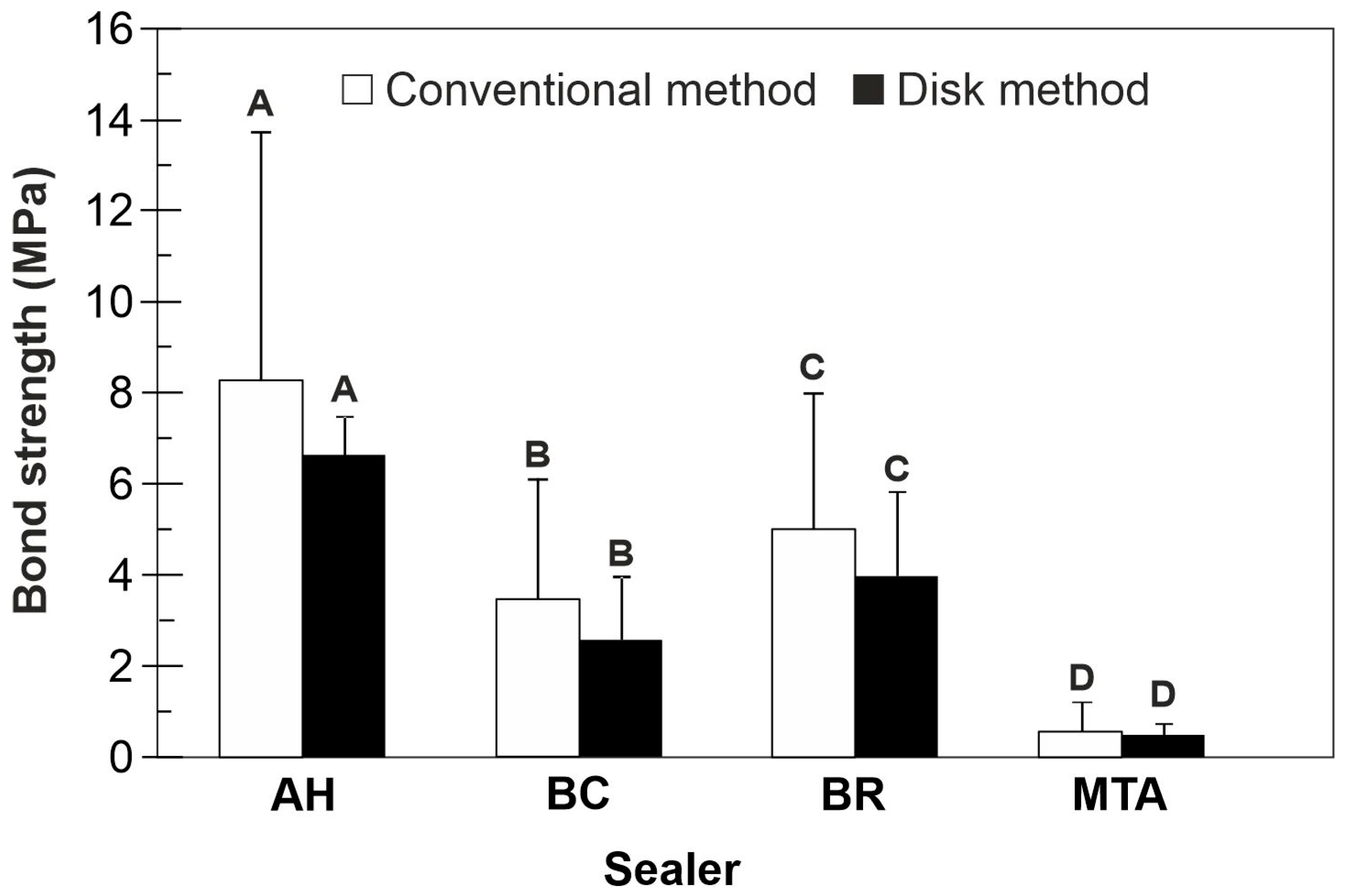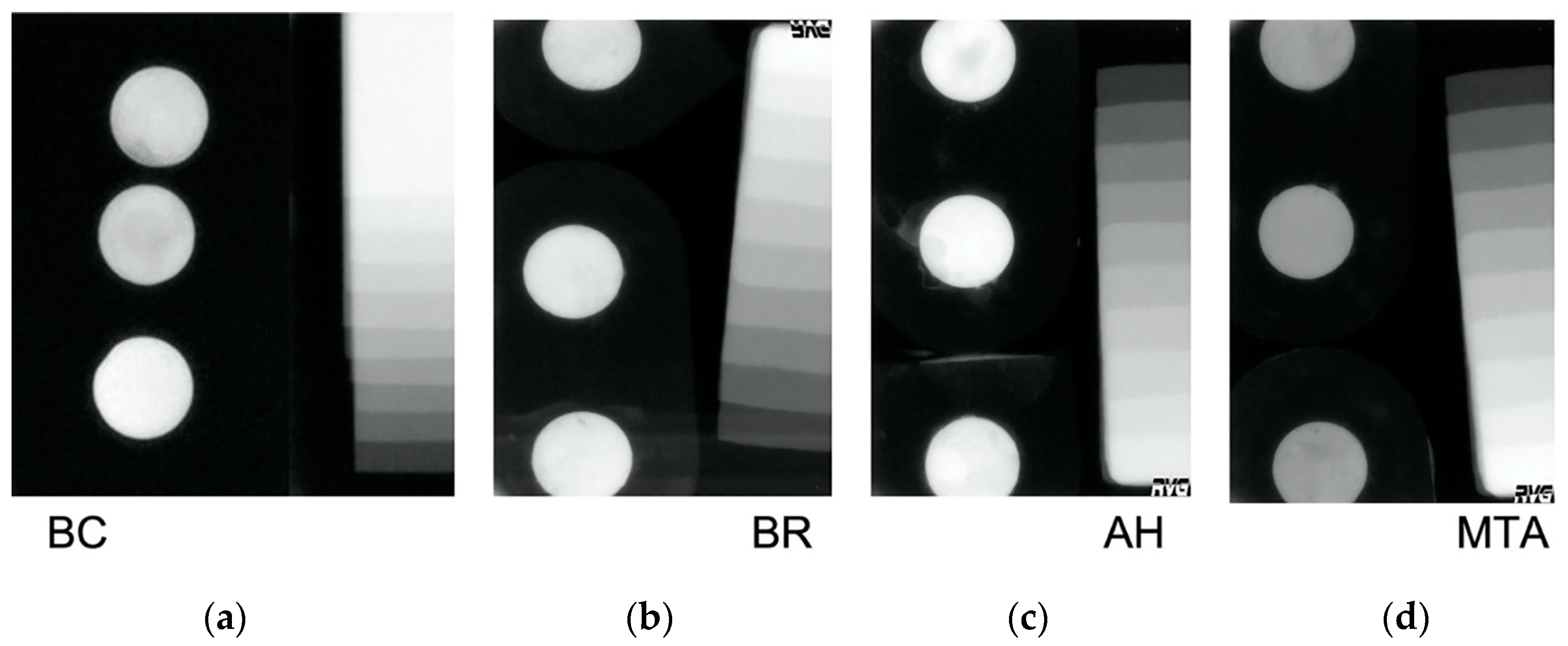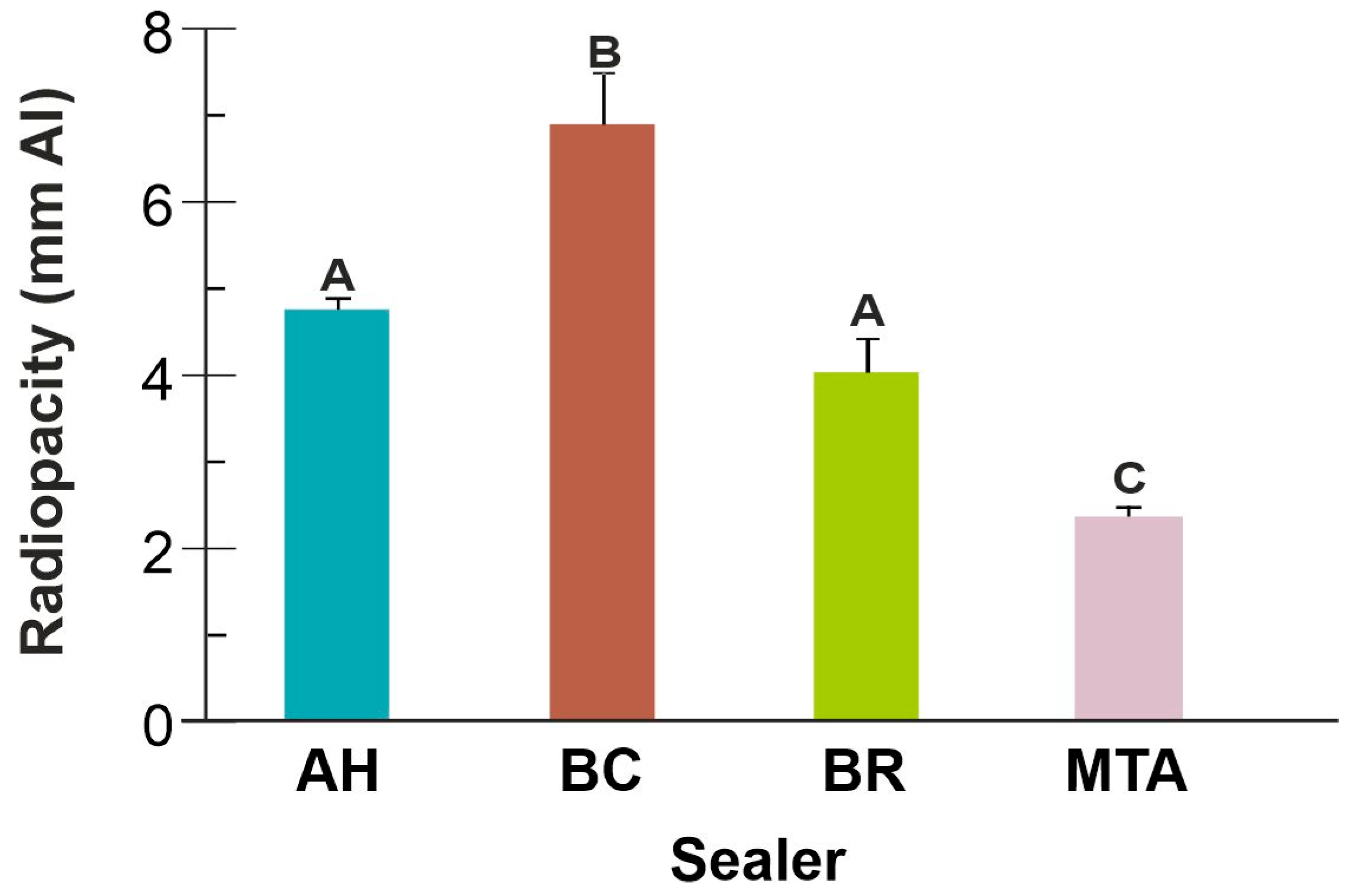Physico-Chemical Properties and Push-Out Bond Strength to Root Dentine of Calcium Silicate-Based Sealers
Abstract
1. Introduction
2. Materials and Methods
2.1. Materials
2.2. Specimen Preparation for Push-Out Bond Strength Measurement
2.2.1. Conventional Method
2.2.2. Disk Method
2.3. Measurement of Push-Out Bond Strength
2.4. Specimen Preparation and Measurement of pH and Radiopacity
2.5. Specimen Preparation and Measurement of Flexural Strength
2.6. Statistical Analysis
3. Results
4. Discussion
5. Conclusions
- Push-out bond strength of calcium silicate-based sealers was lower than that of AH Plus, EndoSequence BC and BioRoot RCS showing superior results compared to MTA Fillapex.
- Push-out bond strength values measured using different testing approaches, the conventional and disk methods, exhibited similar results.
- Since the disk method showed more homogeneous results and required a smaller number of teeth than the conventional method, it may be the preferred method to test the push-out bond strength of calcium silicate-based sealers.
- All calcium silicate-based sealers exhibited higher pH than resin-based AH Plus control sealer.
- Endosequence BC exhibited the highest radiopacity of the tested sealers.
- Radiopacity of MTA Fillapex was the lowest among the tested calcium silicate-based sealers and below the ISO 6876:2001 standard of 3 mm Al.
- The flexural strength of calcium silicate-based sealers was comparable within this group but significantly lower than resin-based AH Plus control.
Author Contributions
Funding
Institutional Review Board Statement
Informed Consent Statement
Data Availability Statement
Conflicts of Interest
References
- Camilleri, J. Classification of hydraulic cements used in dentistry. Front. Dent. Med. 2020, 1, 9. [Google Scholar]
- Al-Haddad, A.; Che Ab Aziz, Z.A. Bioceramic-Based Root Canal Sealers: A Review. Int. J. Biomater. 2016, 2016, 9753210. [Google Scholar] [CrossRef] [PubMed]
- Jeong, J.W.; DeGraft-Johnson, A.; Dorn, S.O.; Di Fiore, P.M. Dentinal Tubule Penetration of a Calcium Silicate-Based Root Canal Sealer with Different Obturation Methods. J. Endod. 2017, 43, 633–637. [Google Scholar] [PubMed]
- Scelza, M.Z.; Da Silva, D.; Scelza, P.; De Noronha, F.; Barbosa, I.B.; Souza, E.; De Deus, G. Influence of a New Push-Out Test Method on the Bond Strength of Three Resin-Based Sealers. Int. Endod. J. 2015, 48, 801–806. [Google Scholar]
- Nagas, E.; Uyanik, M.O.; Eymirli, A.; Cehreli, Z.C.; Vallittu, P.K.; Lassila, L.V.; Durmaz, V. Dentin Moisture Conditions Affect the Adhesion of Root Canal Sealers. J. Endod. 2012, 38, 240–244. [Google Scholar]
- Shokouhinejad, N.; Gorjestani, H.; Ali Nasseh, A.; Hoseini, A.; Mohammadi, M.; Shamshiri, A.R. Push-Out Bond Strength of Gutta-Percha with a New Bioceramic Sealer in the Presence or Absence of Smear Layer. Aust. Endod. J. 2013, 39, 102–106. [Google Scholar]
- Tedesco, M.; Santos Felippe, M.C.; Felippe, W.T.; Hecke Alves, A.M.; Antunes Bortoluzzi, E.; Silveira Teixeira, C. Adhesive Interface and Bond Strength of Endodontic Sealers to Root Canal Dentine after Immersion in Phosphate-Buffered Saline. Microsc. Res. Tech. 2014, 77, 1015–1022. [Google Scholar]
- DeLong, C.; He, J.; Woodmansey, K.F. The Effect of Obturation Technique on the Push-Out Bond Strength of Calcium Silicate Sealers. J. Endod. 2015, 41, 385–388. [Google Scholar]
- Silva, E.J.; Carvalho, N.K.; Prado, M.C.; Zanon, M.; Senna, P.M.; Souza, E.M.; De-Deus, G. Push-Out Bond Strength of Injectable Pozzolan-Based Root Canal Sealer. J. Endod. 2016, 42, 1656–1659. [Google Scholar]
- Carvalho, N.K.; Prado, M.C.; Senna, P.M.; Neves, A.A.; Souza, E.M.; Fidel, S.R.; Sassone, L.M.; Silva, E.J.N.L. Do Smear-Layer Removal Agents Affect the Push-Out Bond Strength of Calcium Silicate-Based Endodontic Sealers? Int. Endod. J. 2017, 50, 612–619. [Google Scholar] [CrossRef]
- Stuart, C.H.; Schwartz, S.A.; Beeson, T.J.; Owatz, C.B. Enterococcus Faecalis: Its Role in Root Canal Treatment Failure and Current Concepts in Retreatment. J. Endod. 2006, 32, 93–98. [Google Scholar] [CrossRef] [PubMed]
- Gandolfi, M.G.; Taddei, P.; Modena, E.; Siboni, F.; Prati, C. Biointeractivity-Related Versus Chemi/Physiosorption-Related Apatite Precursor-Forming Ability of Current Root End Filling Materials. J. Biomed. Mater. Res. B Appl. Biomater. 2013, 101, 1107–1123. [Google Scholar] [CrossRef] [PubMed]
- Poggio, C.; Dagna, A.; Ceci, M.; Meravini, M.V.; Colombo, M.; Pietrocola, G. Solubility and pH of Bioceramic Root Canal Sealers: A Comparative Study. J. Clin. Exp. Dent. 2017, 9, e1189–e1194. [Google Scholar] [CrossRef] [PubMed]
- Zordan-Bronzel, C.L.; Esteves Torres, F.F.; Tanomaru-Filho, M.; Chávez-Andrade, G.M.; Bosso-Martelo, R.; Guerreiro-Tanomaru, J.M. Evaluation of Physicochemical Properties of a New Calcium Silicate-Based Sealer, Bio-C Sealer. J. Endod. 2019, 45, 1248–1252. [Google Scholar] [CrossRef]
- Urban, K.; Neuhaus, J.; Donnermeyer, D.; Schäfer, E.; Dammaschke, T. Solubility and pH Value of 3 Different Root Canal Sealers: A Long-Term Investigation. J. Endod. 2018, 44, 1736–1740. [Google Scholar] [CrossRef]
- Ioannidis, K.; Mistakidis, I.; Beltes, P.; Karagiannis, V. Spectrophotometric Analysis of Coronal Discolouration Induced by Grey and White MTA. Int. Endod. J. 2013, 46, 137–144. [Google Scholar] [CrossRef]
- Możyńska, J.; Metlerski, M.; Lipski, M.; Nowicka, A. Tooth Discoloration Induced by Different Calcium Silicate-Based Cements: A Systematic Review of In Vitro Studies. J. Endod. 2017, 43, 1593–1601. [Google Scholar] [CrossRef]
- Marciano, M.A.; Costa, R.M.; Camilleri, J.; Mondelli, R.F.; Guimarães, B.M.; Duarte, M.A. Assessment of Color Stability of White Mineral Trioxide Aggregate Angelus and Bismuth Oxide in Contact with Tooth Structure. J. Endod. 2014, 40, 1235–1240. [Google Scholar] [CrossRef]
- Marciano, M.A.; Duarte, M.A.; Camilleri, J. Calcium Silicate-Based Sealers: Assessment of Physicochemical Properties, Porosity, and Hydration. Dent. Mater. 2016, 32, e30–e40. [Google Scholar] [CrossRef]
- Siboni, F.; Taddei, P.; Zamparini, F.; Prati, C.; Gandolfi, M.G. Properties of BioRoot RCS, a Tricalcium Silicate Endodontic Sealer Modified with Povidone and Polycarboxylate. Int. Endod. J. 2017, 50, e120–e136. [Google Scholar] [CrossRef]
- Prüllage, R.K.; Urban, K.; Schäfer, E.; Dammaschke, T. Material Properties of a Tricalcium Silicate-Containing, a Mineral Trioxide Aggregate-Containing, and an Epoxy Resin-Based Root Canal Sealer. J. Endod. 2016, 42, 1784–1788. [Google Scholar] [CrossRef] [PubMed]
- Candeiro, G.T.; Correia, F.C.; Duarte, M.A.; Ribeiro-Siqueira, D.C.; Gavini, G. Evaluation of Radiopacity, pH, Release of Calcium Ions, and Flow of a Bioceramic Root Canal Sealer. J. Endod. 2012, 38, 842–845. [Google Scholar] [CrossRef] [PubMed]
- Ballal, N.V.; Sona, M.; Tay, F.R. Effects of Smear Layer Removal Agents on the Physical Properties and Microstructure of Mineral Trioxide Aggregate Cement. J. Dent. 2017, 66, 32–36. [Google Scholar] [CrossRef] [PubMed]
- Marashdeh, M.Q.; Friedman, S.; Lévesque, C.; Finer, Y. Esterases Affect the Physical Properties of Materials Used to Seal the Endodontic Space. Dent. Mater. 2019, 35, 1065–1072. [Google Scholar]
- ISO 6876:2012; Dentistry—Root Canal Sealing Materials. International Organization for Standardization: Geneva, Switzerland, 2012.
- Malka, V.B.; Hochscheidt, G.L.; Larentis, N.L.; Grecca, F.S.; Fontanella, V.R.; Kopper, P.M. A new in vitro method to evaluate radio-opacity of endodontic sealers. Dentomaxillofac. Radiol. 2015, 44, 20140422. [Google Scholar] [CrossRef]
- Fisher, M.A.; Berzins, D.W.; Bahcall, J.K. An In Vitro Comparison of Bond Strength of Various Obturation Materials to Root Canal Dentin Using a Push-Out Test Design. J. Endod. 2007, 33, 856–858. [Google Scholar]
- Lee, K.W.; Williams, M.C.; Camps, J.J.; Pashley, D.H. Adhesion of Endodontic Sealers to Dentin and Gutta-Percha. J. Endod. 2002, 28, 684–688. [Google Scholar] [CrossRef]
- Nunes, V.H.; Silva, R.G.; Alfredo, E.; Sousa-Neto, M.D.; Silva-Sousa, Y.T. Adhesion of Epiphany and AH Plus sealers to human root dentin treated with different solutions. Braz. Dent. J. 2008, 19, 46–50. [Google Scholar] [CrossRef]
- Atmeh, A.R.; Chong, E.Z.; Richard, G.; Festy, F.; Watson, T.F. Dentin-cement interfacial interaction: Calcium silicates and polyalkenoates. J. Dent. Res. 2012, 91, 454–459. [Google Scholar]
- Elsayed, M.A.; Hassanien, E.E.; Elgendy, A.A.E. Ageing of TotalFill BC Sealer and MTA Fillapex in Simulated Body Fluid. Eur. Endod. J. 2021, 6, 183–188. [Google Scholar]
- Han, L.; Okiji, T. Uptake of Calcium and Silicon Released from Calcium Silicate-Based Endodontic Materials into Root Canal Dentine. Int. Endod. J. 2011, 44, 1081–1087. [Google Scholar] [CrossRef] [PubMed]
- El-Ma’aita, A.M.; Qualtrough, A.J.; Watts, D.C. The Effect of Smear Layer on the Push-Out Bond Strength of Root Canal Calcium Silicate Cements. Dent. Mater. 2013, 29, 797–803. [Google Scholar] [CrossRef] [PubMed]
- De-Deus, G.; Souza, E.; Versiani, M. Methodological considerations on push-out tests in Endodontics. Int. Endod. J. 2015, 48, 501–503. [Google Scholar] [CrossRef] [PubMed]
- Janini, A.C.P.; Pelepenko, L.E.; Gomes, B.P.F.A.; Marciano, M.A. Physico-chemical properties of calcium silicate-based sealers in powder/liquid and ready-to-use forms. Braz. Dent. J. 2022, 33, 18–25. [Google Scholar] [CrossRef]
- Tanomaru-Filho, M.; Cristine Prado, M.; Torres, F.F.E.; Viapiana, R.; Pivoto-João, M.M.B.; Guerreiro-Tanomaru, J.M. Physicochemical Properties and Bioactive Potential of a New Epoxy Resin-Based Root Canal Sealer. Braz. Dent. J. 2019, 30, 563–568. [Google Scholar] [CrossRef]
- Xuereb, M.; Vella, P.; Damidot, D.; Sammut, C.V.; Camilleri, J. In Situ Assessment of the Setting of Tricalcium Silicate-Based Sealers Using a Dentin Pressure Model. J. Endod. 2015, 41, 111–124. [Google Scholar] [CrossRef]
- Húngaro Duarte, M.A.; de Oliveira El Kadre, G.D.; Vivan, R.R.; Guerreiro Tanomaru, J.M.; Tanomaru Filho, M.; de Moraes, I.G. Radiopacity of Portland Cement Associated with Different Radiopacifying Agents. J. Endod. 2009, 35, 737–740. [Google Scholar] [CrossRef]
- Milanovic, I.; Milovanovic, P.; Antonijevic, D.; Dzeletovic, B.; Djuric, M.; Miletic, V. Immediate and Long-Term Porosity of Calcium Silicate-Based Sealers. J. Endod. 2020, 46, 515–523. [Google Scholar] [CrossRef]
- Antunes, T.B.M.; Janini, A.C.P.; Pelepenko, L.E.; Abuna, G.F.; Paiva, E.M.; Sinhoreti, M.A.C.; Raimundo, I.M., Jr.; Gomes, B.P.F.A.; de-Jesus-Soares, A.; Marciano, M.A. Heating stability, physical and chemical analysis of calcium silicate-based endodontic sealers. Int. Endod. J. 2021, 54, 1175–1188. [Google Scholar] [CrossRef]
- Khalil, I.; Naaman, A.; Camilleri, J. Properties of Tricalcium Silicate Sealers. J. Endod. 2016, 42, 1529–1535. [Google Scholar] [CrossRef]
- Chen, J.H.; Raman, V.; Kuehne, S.A.; Camilleri, J.; Hirschfeld, J. Chemical, Antibacterial, and Cytotoxic Properties of Four Different Endodontic Sealer Leachates Over Time. J. Endod. 2024, 50, 1612–1621. [Google Scholar] [PubMed]
- Kharouf, N.; Sauro, S.; Eid, A.; Zghal, J.; Jmal, H.; Seck, A.; Macaluso, V.; Addiego, F.; Inchingolo, F.; Affolter-Zbaraszczuk, C.; et al. Physicochemical and Mechanical Properties of Premixed Calcium Silicate and Resin Sealers. J. Funct. Biomater. 2023, 14, 9. [Google Scholar] [CrossRef] [PubMed]
- Branstetter, J.; von Fraunhofer, J.A. The physical properties and sealing action of endodontic sealer cements: A review of the literature. J. Endod. 1982, 8, 312–316. [Google Scholar] [PubMed]
- Sfeir, G.; Zogheib, C.; Patel, S.; Giraud, T.; Nagendrababu, V.; Bukiet, F. Calcium Silicate-Based Root Canal Sealers: A Narrative Review and Clinical Perspectives. Materials 2021, 14, 3965. [Google Scholar] [CrossRef]





| Sealer | Manufacturer | Lot Number | Composition * | Mixing |
|---|---|---|---|---|
| BioRoot RCS (BR) | Septodont, Saint Maur Des Fosses, France | B24408 | Powder: tricalcium silicate, zirconium oxide, excipients Liquid: aqueous solution of calcium chloride, excipients | Mix 1 spoon of powder with 5 drops of liquid using a plastic spatula on a paper pad |
| EndoSequence BC (BC) | Brassler, Savannah, GA, USA | 24003SP | Zirconium oxide, calcium silicates, calcium phosphate monobasic, calcium hydroxide, filler, thickening agents | Extrude desired amount using a disposable applicator tip |
| MTA Fillapex (MTA) | Angelus, Londrina, PR, Brasil | 71694 | Salicylate resin, diluting resin, natural resin, calcium tungstate, nanoparticulate silica, MTA, pigments | Dual syringe: The dual syringe ensures equal volume mixing in a 1:1 ratio. Press plunger to extrude material directly |
| AH Plus (AH) | Dentsply DeTrey, Konstanz, Germany | 2307000242 | Paste A: bisphenol A epoxy resin, bisphenol F epoxy resin, calcium tungstate, zirconium oxide, silica, iron oxide pigments Paste B: dibenzylamine, aminoadamantane, tricyclodecane-diamide, calcium tungstate, zirconium oxide, silica, silicone oil | Extrude equal volume units (1:1). Mix with a metal spatula on a glass mixing pad until achieving homogeneous consistency |
| Time, Day | pH (Mean ± SD) | |||
|---|---|---|---|---|
| Sealer | ||||
| AH | BC | BR | MTA | |
| 1 | 8.79 ± 0.34 A | 10.65 ± 0.40 AB | 11.08 ± 0.02 A | 9.26 ± 0.13 B |
| 3 | 9.01 ± 0.21 A | 11.64 ± 0.17 A | 10.63 ± 0.23 A | 9.82 ± 0.22 AB |
| 7 | 9.32 ± 1.08 A | 10.88 ± 0.33 AB | 10.37 ± 0.22 AB | 9.87 ± 0.74 AB |
| 14 | 9.12 ± 0.60 A | 11.74 ± 0.41 A | 10.39 ± 0.38 AB | 9.98 ± 0.46 AB |
| 21 | 9.57 ± 0.94 A | 11.58 ± 0.48 AB | 10.79 ± 0.22 A | 11.2 ± 0.99 A |
| 28 days | 9.13 ± 0.08 A | 9.83 ± 1.19 B | 9.67 ± 0.66 B | 9.94 ± 0.15 AB |
Disclaimer/Publisher’s Note: The statements, opinions and data contained in all publications are solely those of the individual author(s) and contributor(s) and not of MDPI and/or the editor(s). MDPI and/or the editor(s) disclaim responsibility for any injury to people or property resulting from any ideas, methods, instructions or products referred to in the content. |
© 2025 by the authors. Licensee MDPI, Basel, Switzerland. This article is an open access article distributed under the terms and conditions of the Creative Commons Attribution (CC BY) license (https://creativecommons.org/licenses/by/4.0/).
Share and Cite
Milanovic, I.; Miletic, V.; Dzeletovic, B.; Antonijevic, D.; Savic Stankovic, T.; Pavlovic, D.; Despotovic, A.; Petrovic, V. Physico-Chemical Properties and Push-Out Bond Strength to Root Dentine of Calcium Silicate-Based Sealers. J. Funct. Biomater. 2025, 16, 131. https://doi.org/10.3390/jfb16040131
Milanovic I, Miletic V, Dzeletovic B, Antonijevic D, Savic Stankovic T, Pavlovic D, Despotovic A, Petrovic V. Physico-Chemical Properties and Push-Out Bond Strength to Root Dentine of Calcium Silicate-Based Sealers. Journal of Functional Biomaterials. 2025; 16(4):131. https://doi.org/10.3390/jfb16040131
Chicago/Turabian StyleMilanovic, Ivana, Vesna Miletic, Bojan Dzeletovic, Djordje Antonijevic, Tatjana Savic Stankovic, Danilo Pavlovic, Ana Despotovic, and Violeta Petrovic. 2025. "Physico-Chemical Properties and Push-Out Bond Strength to Root Dentine of Calcium Silicate-Based Sealers" Journal of Functional Biomaterials 16, no. 4: 131. https://doi.org/10.3390/jfb16040131
APA StyleMilanovic, I., Miletic, V., Dzeletovic, B., Antonijevic, D., Savic Stankovic, T., Pavlovic, D., Despotovic, A., & Petrovic, V. (2025). Physico-Chemical Properties and Push-Out Bond Strength to Root Dentine of Calcium Silicate-Based Sealers. Journal of Functional Biomaterials, 16(4), 131. https://doi.org/10.3390/jfb16040131







